November is a month of transition within the British racing landscape when the fleet-footed, blue-blooded thoroughbreds that have enthralled and entertained us over the summer months sign off for the season and their National Hunt counterparts emerge from hibernation en masse, ready to fulfil their owners’ dreams of big-race glory at the Cheltenham and Aintree festivals.
Until relatively recently, the dawn of a new jumps season would have meant little – certainly in terms of direct involvement – to the Thompson family’s Cheveley Park Stud, the Newmarket-based racing and breeding operation whose iconic red, white and blue silks have been associated with any number of outstanding performers on the Flat.
All that changed in 2018 when David Thompson, the entrepreneur and businessman who bought Cheveley Park – then in receivership – with wife Patricia in 1975 decided he’d rather like to prolong the fun and have something to keep him occupied over the winter months.
So, a team of jumps horses was assembled over the course of the year and dispatched to some of Ireland’s premier trainers.
As befits a man whose brilliant business brain helped turn Hillsdown Holdings into a FTSE 100 company with an annual turnover of £4 billion, the results have been sensational, showing seven Cheltenham Festival winners in three years and 13 Grade 1s in total. Not bad going for what his son, Richard, who has inherited his father’s entrepreneurial spirit, calls a “one-off project”.
Sadly, David died in late December aged 84, leaving his family with perhaps the most exiting team of National Hunt horses in Europe. A chat with Patricia and Richard Thompson, along with the stud’s Managing Director Chris Richardson, at the Tattersalls Book 1 Sale helps to clear up the future of the jumps operation.

Patricia Thompson with John Gosden (left) and Frankie Dettori after Inspiral maintains her unbeaten record in the Group 1 Fillies’ Mile at Newmarket | Photo: Bill Selwyn
“We’ll keep them going in David’s memory but there are no plans to buy anything new,” Patricia says. “I don’t understand jump racing completely, but I’ve got more of an idea than I had. I enjoy watching it.
“Frankly, there’s no residual value. We’re trying to build families as we have done for years – that’s much more satisfying, really. And I’d much rather buy a nice filly!”
Indeed, on the opening day of Book 1, Mrs T – as Richardson calls her – did splash out on a nice filly, seeing off Juddmonte Farms to land a daughter of No Nay Never out of the English Channel mare Lady Ederle for 825,000 guineas.
For an outfit that presides over one of Britain’s premier broodmare bands, it was a statement of intent that Cheveley Park Stud remains focused on its core goal of breeding top-class racehorses.
Of the purchase, Patricia explains: “It just sort of happened – I wasn’t really thinking of buying anything. Chris showed me four very nice fillies. I liked the first of the four and sometimes you just have to go for it.
“It’s a very nice outcross pedigree. Even if she doesn’t race, she still has a lot of residual value.”
The Cheveley Park Stud policy for the last 20 or so years has been to retain its fillies to race and sell all its colts at public auction. This year’s Book 1 draft featured nine yearlings; seven found new homes for an aggregate of 1,752,000 guineas, or 250,000gns each, with top billing going to a son of Showcasing ex Furbelow – dam of three-time Group 1 victor Advertise – at 450,000gns.
Among the other colts to catch the eye of buyers ringside was lot 247, a 300,000gns son of Ulysses out of the Blame mare Sacre Caroline. He is a half-brother to high-class filly Sacred, winner of the Group 2 Hungerford Stakes in the stud’s silks at Newbury in August.
More than a few eyebrows were raised in 2017 when Ulysses, bred in the purple by Galileo out of Oaks heroine Light Shift, was retired to stand at Cheveley in partnership with his breeder the Niarchos family’s Flaxman Stables, who retain a 25% stake in the horse. The operation had been renowned for its sprint stallions, a pattern that began with its first sire Music Boy, immortalised in a bronze statue that sits outside the stud office, and reached its zenith with the outstanding Pivotal.
However, set against a bloodstock industry that can apparently make up its collective mind on the commercial merits of a stallion in the blink of an eye, the recruitment of Ulysses, who excelled over a mile and a quarter when trained by Sir Michael Stoute, could just prove to be inspired.
His initial crop has produced 13 winners of 15 races at the time of writing, placing him in the top eight of first-season sires in Britain and Ireland. Of his winners, five scored at the first time of asking, including Piz Badile, narrow runner-up in the Group 3 Eyrefield Stakes at Leopardstown on October 23.
“Where we have worked extremely hard with Ulysses is to manage to get him 120 mares every year for four years, which has given him a great platform”
Richardson says: “If you look at our broodmare band, the influence of Dutch Art and Pivotal is significant. We’ve witnessed the success of Galileo on Pivotal with Coolmore. So, to have our own son of Galileo, mated to our own mares, is very exciting.
“With his breeding, Sir Michael aimed him at the Derby, but he brought him back in trip and he was most effective over ten furlongs. I believe his progeny will be more mile, mile-and-a-quarter horses, with some obviously mile-and-a-half horses, but he’s also capable of getting some earlier types.
“Where we have worked extremely hard with Ulysses is to manage to get him 120 mares every year for four years, which has given him a great platform to have 80-95 runners coming on stream every year.
“We have supported the horse with some of our own very nice mares, which we have the advantage of being able to do, and he had a phenomenal book of mares in his first season. We’re also seeing hugely important support from domestic breeders like Meon Valley and Hascombe and Valiant, for example.”
He continues: “The feedback we’ve received from our trainers has been most encouraging. They then talk to other breeders who have horses with them and suddenly you have people going to the sales and spending 300,000gns on a son of Ulysses. It shows he has caught people’s imagination. We hope that he will be one of the sons of the late Galileo – along with the likes of Australia, who is also doing well – to carry the mantle.”
Time will tell whether any of the 29 two-year-olds by Ulysses that Cheveley has in training will develop into high-class performers at three. At present they’ll all have to go some to outrank star filly Inspiral, a daughter of Frankel unbeaten in four races this year and most recently seen recording a decisive success in the Fillies’ Mile at Newmarket on October 8.
Inspiral will bid to carry the Cheveley silks to a first Classic victory since Confidential Lady and Seb Sanders captured the 2006 Prix de Diane at Chantilly. Yet as a Group 1 winner already, her future in the paddocks is assured for an operation that is always trying to raise the bar.

Inspiral and Frankie Dettori record a decisive success in the Group 1 Fillies’ Mile at Newmarket on October 8 | Photo: Bill Selwyn
“We’re pruning slightly, but we started that before the pandemic so that we have a more elite broodmare band,” Patricia explains. “We had so many at one point they couldn’t fit within our own grounds.”
Richardson adds: “We hope to have around 100 mares by the end of the year. Some will be sent to the December sales – we are certainly focusing on quality over quantity.
“We have fewer stallions, so we have less need for the sort of mares required to support certain sires in their fourth or fifth year. A figure of 100 mares allows around 70 foals each year. That’s 60 yearlings, 30 colts and 30 fillies. The fillies will go into training and the colts will be offered at the sales.”
Such a considered approach to breeding and racing does not always seem to be reflected in an industry where the ‘more is better’ philosophy usually triumphs. Mention of Music Boy is a reminder that stallions in this country once covered book sizes of around 50 at a time when a variety of bloodlines prevailed.
“We’d all like to see limits [on book sizes] or the industry will eat itself. But I think, quite naturally, everyone is thinking of themselves. It’s about dominance and money”
Patricia says: “It used to be more fun, I think. The gene pool was certainly healthier. What do I think of the situation now? It’s concerning and I wish we could go back.
“We’d all like to see limits [on book sizes] or the industry will eat itself. But I think, quite naturally, everyone is thinking of themselves. It’s about dominance and money.
“We should be taking the longer-term view, but nobody will agree to limits while they are making lots of money by so many coverings. I’ve seen it all before in business. In an ideal world we would be working together for the sake of the industry, but that’s not happening. I believe you weaken the market with too many horses by the same stallion for sale.”
Richardson adds: “The commercial world of breeding has changed the concept of how one should do business in a more sensible way. Now people stand a stallion and take a view that their investment must be returned within one or two seasons.
“You need as many on the ground as possible – firstly to bolster your income and secondly to compete with the other stallions that have high numbers as well. Otherwise you’re at a serious disadvantage.
“The stallion market has changed drastically and Ireland has become very strong. The Irish are prepared to take a chance on a good two-year-old and retire that horse after its juvenile career.
“It’s worked very well with the likes of Mehmas. Suddenly their progeny are all the rage. We looked at doing that with [Group 1-winning two-year-old] Unfortunately. Now he’s in Ireland and his first crop are yearlings.”
Back to the jumpers and there are a host of established stars and upcoming talents to look forward to this season, including Allaho, Quilixios and Sir Gerhard, the trio that enjoyed Grade 1 glory at the Cheltenham Festival in March, helping Cheveley to leading owner honours.
Yet it’s a different animal that is uppermost in the thoughts of Richard Thompson, and for good reason.
“I’ll put my hand up for A Plus Tard,” he says. “The Grade 1 Savills Chase [in December 2020] is the last race my father ever watched. For me personally that’s the one.

Allaho: Ryanair Chase winner is one of the top-notch jumpers for the Cheveley Park team | Photo: George Selwyn
“Of course, Envoi Allen and Allaho and the younger horses are up there, but A Plus Tard is the one. For that to be the last race he watched on TV… it was just so exciting. When we bought the jumpers that was exactly the sort of race we were looking to win.
“Dad always liked jump racing, but he had previously bought older horses and sometimes they came with a few injuries or weren’t quite right – this time he bought younger horses, which is incredible because he was in his 80s, when he could have bought younger horses ten or 20 years ago. But that was him.”
Richard continues: “My father had a bit of magic dust. He did stuff occasionally that was outside the box. And it came off. He had that streak of something that was unusual. Our Grand National winner Party Politics [bought as a birthday present for Patricia only a few days before he lined up in the big race at Aintree in 1992] was a great example.
“A lot of it was raw instinct, from the gut. He had a huge appetite for calculated risk – and he could make his mind up very quickly. That was his USP and the advantage he had over other people; weighing things up, making a decision and going for it.”
That attitude towards calculated risk was encapsulated in the identification and purchase of the No Nay Never filly at Book 1. Patricia Thompson remains steadfast in her commitment to racing and breeding thoroughbreds despite the loss of her biggest supporter.
“I met David at 18 and we were married for a week shy of 59 years,” she says. “Of course, it could be exhausting at times, but I think I would have been bored with anyone else.
“It has been quite a stressful period and there has been an awful lot to do, but we’ll keep trying to improve all the time.
“I’m not ready to retire yet. I’m happy to watch the jumpers and let Chris and Richard manage them.”



